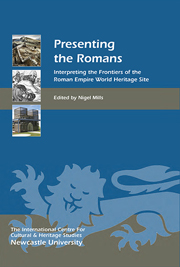Book contents
- Frontmatter
- Contents
- List of Illustrations
- Acknowledgments
- List of Abbreviations
- Preface
- Introduction: Presenting the Romans – Issues and Approaches to Interpretation
- 1 Tradition and Innovation: Creating a New Handbook to the Roman Wall
- 2 Re-enactment and Living History – Issues about Authenticity
- 3 Reconstruction Drawings: Illustrating the Evidence
- 4 Images from the Past: Fibulae as Evidence for the Architectural Appearance of Roman Fort Gates
- 5 Multimedia Interpretation Techniques for Reconstructing the Roman Past at the Limes Museum in Aalen and at the Limes in Baden-Württemberg
- 6 Vindonissa: Changing Presentations of a Roman Legionary Fortress
- 7 Bringing to Life the Ancient City of Viminacium on the Danube
- 8 An International View of Reconstruction
- 9 A Roman Museum for Vienna
- 10 Woerden – Hoochwoert (Dutch Limes): Showing the Invisible
- 11 Mainlimes Mobil: Presenting Archaeology and Museums with the Help of Smartphones
- 12 Voices from the Past: Presenting (re)Constructed Environments through Multimedia Technologies
- 13 Digital Reconstruction and the Public Interpretation of Frontiers
- 14 Information, Disinformation and Downright Lies: Portraying the Romans
- 15 Romanes eunt Domus?
- 16 The Living Frontier: the Passing of Time on Hadrian's Wall
- 17 The Hadrian's Wall Interpretation Framework: Audience Research
- 18 The Hadrian's Wall Interpretation Framework
- 19 Applying the Hadrian's Wall Interpretation Framework
- List of Contributors
- Index
- Heritage Matters
18 - The Hadrian's Wall Interpretation Framework
Published online by Cambridge University Press: 05 September 2013
- Frontmatter
- Contents
- List of Illustrations
- Acknowledgments
- List of Abbreviations
- Preface
- Introduction: Presenting the Romans – Issues and Approaches to Interpretation
- 1 Tradition and Innovation: Creating a New Handbook to the Roman Wall
- 2 Re-enactment and Living History – Issues about Authenticity
- 3 Reconstruction Drawings: Illustrating the Evidence
- 4 Images from the Past: Fibulae as Evidence for the Architectural Appearance of Roman Fort Gates
- 5 Multimedia Interpretation Techniques for Reconstructing the Roman Past at the Limes Museum in Aalen and at the Limes in Baden-Württemberg
- 6 Vindonissa: Changing Presentations of a Roman Legionary Fortress
- 7 Bringing to Life the Ancient City of Viminacium on the Danube
- 8 An International View of Reconstruction
- 9 A Roman Museum for Vienna
- 10 Woerden – Hoochwoert (Dutch Limes): Showing the Invisible
- 11 Mainlimes Mobil: Presenting Archaeology and Museums with the Help of Smartphones
- 12 Voices from the Past: Presenting (re)Constructed Environments through Multimedia Technologies
- 13 Digital Reconstruction and the Public Interpretation of Frontiers
- 14 Information, Disinformation and Downright Lies: Portraying the Romans
- 15 Romanes eunt Domus?
- 16 The Living Frontier: the Passing of Time on Hadrian's Wall
- 17 The Hadrian's Wall Interpretation Framework: Audience Research
- 18 The Hadrian's Wall Interpretation Framework
- 19 Applying the Hadrian's Wall Interpretation Framework
- List of Contributors
- Index
- Heritage Matters
Summary
Arguably Hadrian's Wall is more relevant today than it was in the past: it stands as a symbol of our identity as well as our heritage and serves as a cultural link across continents, not simply as a tourist attraction but a means which connects our understanding of the world today.
Roz Elliott, Deputy Head, Burnside College, WallsendIntroduction
All Year 7 pupils who attend Burnside Business and enterprise College in Wallsend explore aspects of Hadrian's Wall, including its history. The college is located near Segedunum Roman fort and was designed with a ground plan based on the shape of a flattened Roman legionary helmet. Roz Elliott is Deputy Head and, for her and her students, perhaps the most important aspect of the Wall and all that it represents is how it helps to promote community cohesion by providing a context through which to explore contemporary issues of identity and multiculturalism. The soldiers stationed at Segedunum and at other forts along Hadrian's Wall came from many different parts of the Empire. The students can explore what it might have been like to have been stationed in a foreign land, to marry locally, to adapt to local ways of life yet maintain links with home, and relate this to their modern world.
- Type
- Chapter
- Information
- Presenting the RomansInterpreting the Frontiers of the Roman Empire World Heritage Site, pp. 171 - 180Publisher: Boydell & BrewerPrint publication year: 2013

